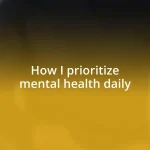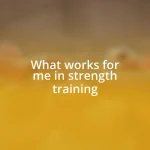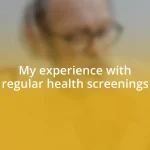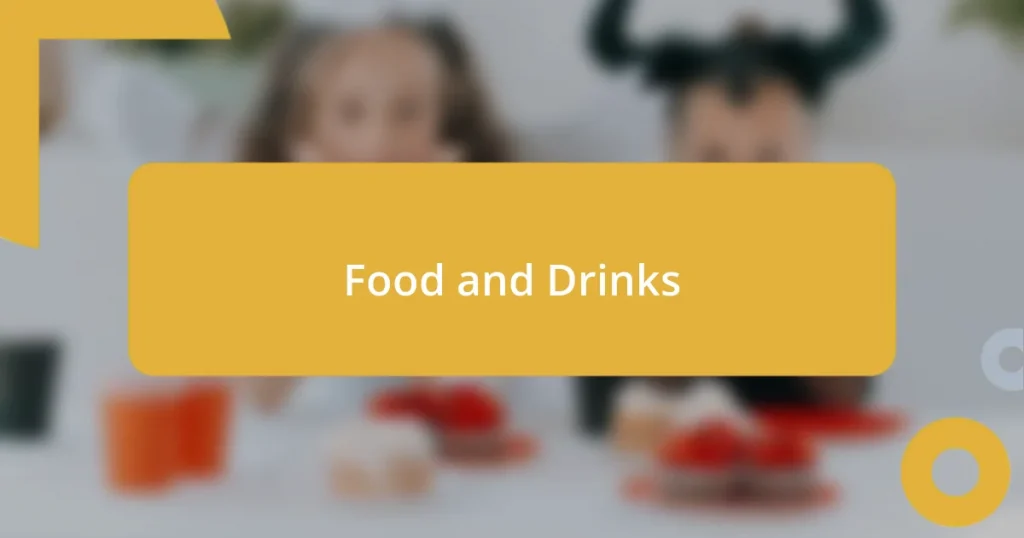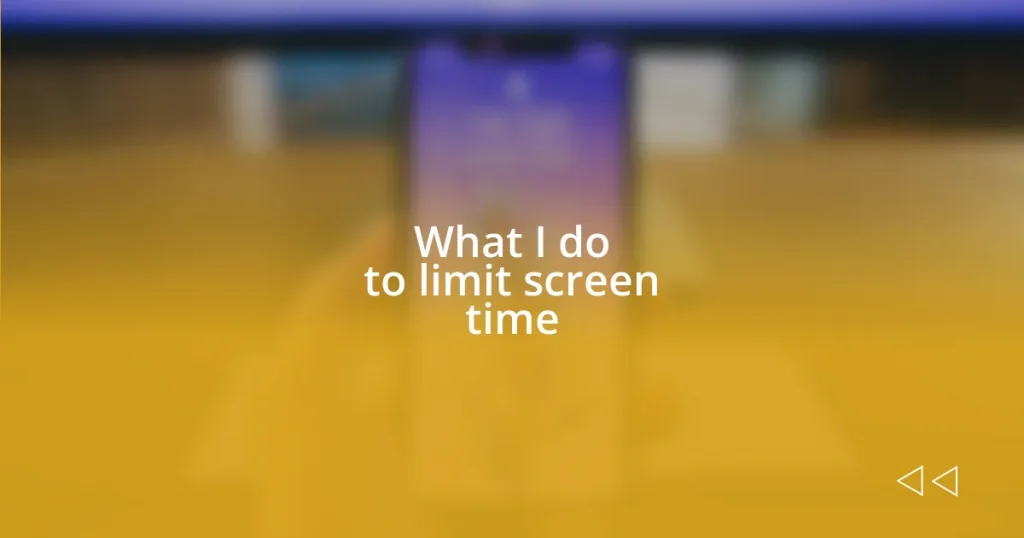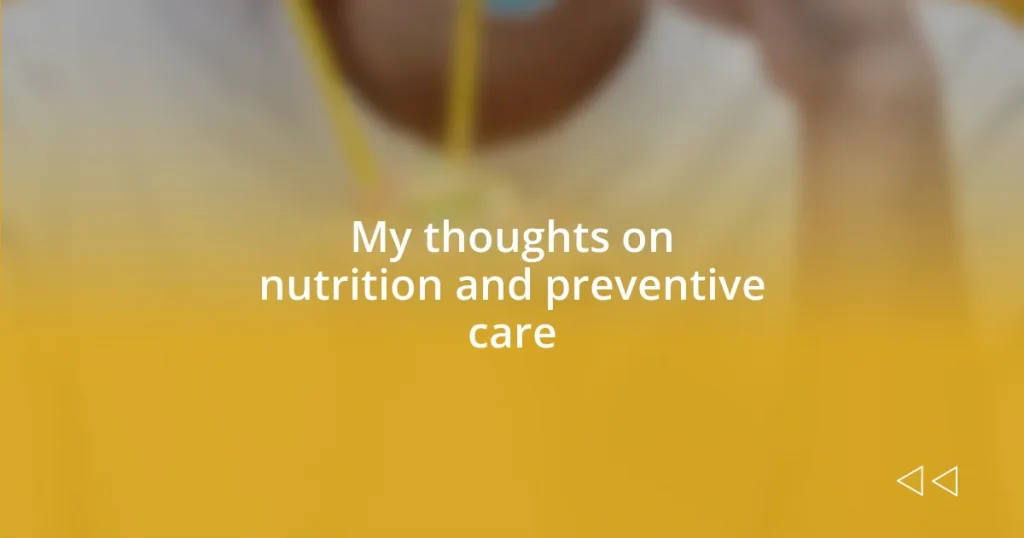Key takeaways:
- Understanding youth health needs involves recognizing the significance of mental wellbeing and providing safe spaces for open discussions.
- Effective engagement strategies include incorporating technology, peer influence, and hands-on activities to make health topics relatable and enjoyable.
- Collaborating with community organizations enhances youth participation and fosters a sense of ownership in health education initiatives.

Understanding Youth Health Needs
Understanding the health needs of youth is crucial to effectively engaging them in meaningful conversations. I remember chatting with a group of teenagers who were concerned about mental health but felt isolated in their struggles. It made me realize that while physical health often gets the limelight, emotional wellbeing is just as significant—how can we truly support youth if we don’t recognize what weighs on their minds?
I’ve also noticed that many young people crave connection and authenticity in health discussions. I once facilitated a workshop where attendees shared their experiences with body image. Their openness highlighted something pivotal: adolescents need a safe space to express their fears and aspirations. When we ask the right questions, such as “What does being healthy mean to you?” we invite them to share stories that are important to them.
Moreover, youth are navigating a world filled with noise—from social media pressures to an overload of information. I often ponder, how can we distill complex health topics into relatable concepts that resonate with their lived experiences? By integrating their perspectives and aligning health topics with their realities, we foster an engaging dialogue that respects their unique journeys.

Identifying Effective Engagement Strategies
Engaging youth in health topics requires strategies that resonate with their lives. When I hosted a local health fair, I noticed how interactive booths drew in young participants. They were much more willing to engage when they could touch, see, and experience the information firsthand. It’s an eye-opener; hands-on experiences not only foster curiosity but also empower them to explore health topics in a more meaningful way.
To identify effective engagement strategies, consider these approaches:
- Incorporate Technology: Use apps and social media platforms they already use to share information.
- Utilize Peer Influence: Encourage youth leaders or popular figures to talk about health topics.
- Facilitate Active Participation: Create workshops or activities where they can express their opinions and ideas.
- Make It Personal: Tailor discussions around their interests, challenges, and realities.
- Create Safe Spaces: Foster environments where they feel comfortable sharing their thoughts without judgment.
From my experience, when youth see their world reflected in health discussions, they’re more likely to engage. It’s about bridging that gap between abstract concepts and their day-to-day lives—something I learned during a community brainstorming session where attendees shared what health meant to them. Their input was not just enlightening; it was transformative for our collective approach.

Utilizing Technology for Engagement
Utilizing technology for youth engagement in health topics is not just innovative; it’s essential. I recall an online seminar I participated in, where teens could join from the comfort of their own homes. This accessibility broke down barriers and made participation feel less daunting. It’s fascinating how technology can transform a conversation about mental health into an engaging dialogue through the use of interactive polls and chat functions. By leveraging these tools, we can create a space where young voices are amplified and heard.
On another occasion, I used a popular social media platform to launch a campaign focused on nutrition education. By posting relatable videos and challenges that encouraged healthy eating habits, I was overwhelmed by how quickly the youth engaged. Suddenly, health topics weren’t just stale information; they became part of their social experience. This approach made me understand how effectively technology can turn mundane subjects into engaging content that resonates with their daily lives and interests.
Furthermore, gamification has proven to be a game-changer. When I introduced a health trivia app during a community event, I noticed enthusiastic participation. Young people were not just passively absorbing information; they actively competed and collaborated with friends. It reminded me that when we make learning fun and interactive, youth can develop a genuine interest in their health—something they may not have considered otherwise.
| Technology Integration Method | engagement Strategy |
|---|---|
| Interactive Online Seminars | Promotes accessibility and participation |
| Social Media Campaigns | Transforms health topics into engaging content |
| Gamification | Encourages competition and collaboration among peers |

Creating Interactive Health Programs
Creating interactive health programs requires a blend of creativity and understanding of what resonates with youth. I remember when I organized a workshop where participants could create their own smoothie recipes. The excitement in the room was palpable; not only were they learning about nutrition, but they were also expressing themselves through flavors. It made me realize how simple activities can turn abstract health concepts into tangible experiences, fostering a deeper connection to the subject matter.
Another effective strategy has been incorporating art into health discussions. During a recent event, I set up a mural where attendees could paint their visions of a healthy community. Watching them engage, I felt a surge of joy as their faces lit up with creativity and pride. It struck me how art can be a powerful medium to express ideas about health, encouraging participation from those who might otherwise remain silent. This experience left me pondering: how often do we underestimate the power of creative expression in health education?
Additionally, I’ve found immense value in peer-led initiatives. I recall a time when a group of motivated youth took charge of planning a health awareness day. Their passion was contagious, and it transformed the event into a lively exchange! The energy they brought not only educated their peers but also instilled a sense of ownership in the health topics discussed. It prompted me to ask myself, how can we further empower youth to lead these conversations? Giving them the platform to share their voices can foster a community where health becomes a shared responsibility.

Collaborating with Community Organizations
Collaborating with community organizations has been a cornerstone of my work in engaging youth on health topics. One memorable partnership was with a local youth center, where we co-developed a health fair. Watching young people take charge of planning activities, like interactive health stations, was electrifying. It was a vivid reminder of how community collaboration can amplify youth voices and foster investment in their own health education.
I vividly recall when a local nonprofit dedicated to mental health reached out to us. Together, we hosted a series of discussions that confronted stigma around mental health among teenagers. What struck me was the openness of the conversations. Young people expressed their challenges and triumphs, creating a supportive atmosphere that was healing in itself. This experience reaffirmed my belief: when community organizations and youth come together, they can cultivate a safe space where important health topics emerge and flourish organically.
Moreover, I’ve seen firsthand how integrating local businesses into outreach initiatives can enhance engagement. At one event, a nearby gym offered free fitness classes, and I noticed an uptick in attendance. It made me think about how local entities can motivate youth to step out and be active. The enthusiasm these collaborations spark can bridge gaps and create lasting connections between young people and their health. Isn’t it inspiring to see how local involvement shifts perceptions and fuels excitement about health?

Measuring Engagement Outcomes
Measuring engagement outcomes has often been a fascinating journey for me, as it reveals how youth interact with health topics. One memorable instance was during a survey I conducted post-workshop, where I asked participants to rate their interest in various health subjects. The insights were eye-opening; I had expected nutrition to top the list, but mental health emerged as a surprising front-runner. It made me think: how often do we overlook what truly resonates with youth?
Another effective approach I’ve embraced is through follow-up discussions. After hosting an event, I made it a point to circle back and ask attendees about their takeaways and applications in daily life. I vividly remember a participant who shared that they started a meditation practice after our mental health session. Witnessing this tangible change reinforced my belief that measuring engagement isn’t just about numbers; it’s about capturing genuine transformations in attitudes and behaviors.
Also, using social media metrics has played a crucial role in gauging engagement. I recall tracking likes, shares, and comments from posts related to our health initiatives. One post about a youth-led health campaign received an unexpected amount of positive feedback, sparking deeper conversations online. This experience highlighted the tremendous potential of digital platforms to amplify youth voices and foster ongoing discussions around health topics. Isn’t it exciting to realize how these modern tools can shape the narrative of health engagement?

Sustaining Long-Term Interest in Health
Sustaining long-term interest in health can be quite the challenge, but I’ve found that making the content relatable is key. For instance, I once invited a local athlete to share their journey, discussing not only their successes but also the setbacks. The teenagers listened intently, and I could see the connection forming. When youth can see someone like them navigating health challenges, it genuinely sparks their curiosity and motivates ongoing conversations.
One strategy that proved effective was creating interactive workshops around trending health topics. I remember facilitating a session on healthy eating where participants had to prepare a simple dish together. The laughter, the mix-ups with ingredients, and the shared sense of accomplishment were infectious. It felt less like a formal session and more like a fun gathering of friends. This hands-on approach helped cement their interest, as they were not only learning but experiencing health in a joyful way.
I also learned that involving youth in decision-making can sustain their enthusiasm. During one project, I asked a group to brainstorm ideas for upcoming health initiatives. The excitement in the room was palpable as they pitched ideas that reflected their interests. When young people feel their voices matter, it transforms passive interest into active engagement. Have you ever noticed how invested you become when you’re part of the process? That sense of ownership is a powerful motivator for sustained interest in health topics.



